Book contents
- Frontmatter
- Contents
- List of contributors
- Foreword to the second edition
- Preface to the second edition
- 1 Non-medical prescribing: an overview
- 2 Non-medical prescribing in a multidisciplinary team context
- 3 Consultation skills and decision making
- 4 Legal aspects of independent and supplementary prescribing
- 5 Ethical issues in independent and supplementary prescribing
- 6 Psychology and sociology of prescribing
- 7 Applied pharmacology
- 8 Monitoring skills
- 9 Promoting concordance in prescribing interactions
- 10 Evidence-based prescribing
- 11 Extended/supplementary prescribing: a public health perspective
- 12 Calculation skills
- 13 Prescribing in practice: how it works
- 14 Minimising the risk of prescribing error
- Index
- References
4 - Legal aspects of independent and supplementary prescribing
Published online by Cambridge University Press: 10 January 2011
- Frontmatter
- Contents
- List of contributors
- Foreword to the second edition
- Preface to the second edition
- 1 Non-medical prescribing: an overview
- 2 Non-medical prescribing in a multidisciplinary team context
- 3 Consultation skills and decision making
- 4 Legal aspects of independent and supplementary prescribing
- 5 Ethical issues in independent and supplementary prescribing
- 6 Psychology and sociology of prescribing
- 7 Applied pharmacology
- 8 Monitoring skills
- 9 Promoting concordance in prescribing interactions
- 10 Evidence-based prescribing
- 11 Extended/supplementary prescribing: a public health perspective
- 12 Calculation skills
- 13 Prescribing in practice: how it works
- 14 Minimising the risk of prescribing error
- Index
- References
Summary
This chapter sets out to give a precise account of the history of changes brought about by the desire to change prescribing authority, and give definitions of independent and supplementary prescribing, patient group directions (PGDs) and their possible implications for non-medical prescribers (NMPs).
There is a short introduction to how the law is formulated, the differences between civil and criminal law, and how issues such as duty of care, negligence, consent and accountability might affect interactions with patients. Professional issues, such as teamwork and communication, are also addressed. Cases that have gone before the courts are highlighted in an attempt to illustrate how the law has been previously applied. The role of regulatory bodies, such as the Nursing and Midwifery Council and the Health Professions Council, are also noted throughout.
It appears that legal issues are a constant source of worry and fascination for many healthcare practitioners. During the years 2007–2008 some 5400 claims of clinical negligence and 3380 claims of non-clinical negligence were received by the National Health Service Litigation Authority (NHSLA). This resulted in a cost of £633 million paid out in clinical negligence claims (NHSLA 2009). The National Patient Safety Agency report, Safety in Doses: Medication Safety Incidents in the NHS (NPSA 2007), indicates that over 736 million items were prescribed in England, at a cost of £8 billion, in 2006. The scale of activity is enormous.
- Type
- Chapter
- Information
- Independent and Supplementary PrescribingAn Essential Guide, pp. 29 - 41Publisher: Cambridge University PressPrint publication year: 2010

